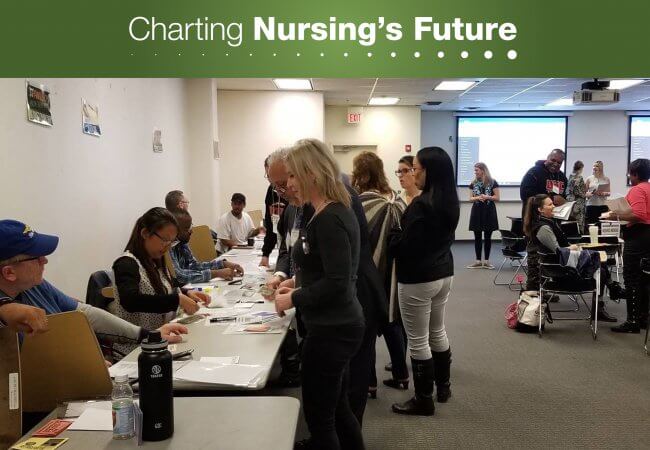
Dec 10, 2018
Simulating Poverty to Prepare Nurses for Community Practice

Nursing students interact with social service providers during a role-playing simulation at The College of New Jersey. Photo courtesy of the New Jersey Nursing Initiative.
Nursing programs that want to teach the full range of factors that influence people’s health have an effective tool at their disposal: the Community Action Poverty Simulation (CAPS).
Over the course of two hours, students get a taste of what it’s like to live without ready access to transportation, child care, nutritious food, affordable housing, and the cash needed to cover utilities and other essentials. Students also discover how challenging it can be to access the social services meant to mitigate poverty’s day-to-day realities.
“The simulation puts things in perspective,” says Katie Hooven, PhD, MBA, RN, assistant professor in the department of nursing at The College of New Jersey (TCNJ), located near Trenton, one of the poorest municipalities in the state. “CAPS helps students understand why health care is not everyone’s number one priority. It’s feeding their children and getting to their job.”
CAPS is overseen by the Missouri Community Action Network (Missouri CAN) to help policy makers, community leaders, students and organizations gain a greater understanding of what it means to live in poverty. At last count, roughly 1,500 organizations had licensed CAPS. Among them are almost 40 nursing schools, but because poverty simulations are often run with students studying a variety of majors and professions, CAPS is reaching nursing students on other campuses as well.
In November 80 TCNJ students from a variety of disciplines met at TCNJ to take part in the school’s sixth poverty simulation. In the center of the room, students congregated in“family groups” based on actual clients of the agencies that make up Missouri CAN. They received money, ID cards, dolls to represent young children and scenarios describing their individual situations.
Around the periphery, volunteers took their places at 15 tables representing community institutions—a local school, a utility company, and a pay-day lender among them. Then over the course of four 15-minute simulated workweeks, students fanned out among the tables in search of resources to meet their needs. At the conclusion of each week, the agencies closed, and students regrouped to figure out how they would acquire what they needed the following week. Periodically, students were dealt “Luck of the Draw Cards” representing vehicle breakdowns, medical bills and other unexpected occurrences that could derail even the best-laid plans.
Students who take part in the CAPS simulation report that they find it emotionally stressful to try and access resources within the time constraints of the exercise. Experiencing the frustration of having to wait to see a social worker or having an office close while they stand in line helps them develop an understanding of what low-income families regularly go through. For one TCNJ nursing student, the experience hit close to home, prompting her to reflect on her own upbringing. “I felt bad for my mom,” she told Hooven.
An increased ability to empathize appears to be one bi-product of CAPS, but it is far from the only goal of the simulation. TCNJ licensed CAPS as part of a larger effort, funded by a New Jersey Nursing Initiative grant, to integrate population health content throughout the nursing curriculum. A key goal of the project is to prepare students to mobilize community resources to achieve better health outcomes for their patients. Many TCNJ nursing courses now supplement traditional, hospital-based acute-care activities with community-based activities such as attending birthing classes, conducting home visits, or screening schoolchildren for various health conditions.
“We need a better focus on primary prevention,” says Hooven. “We need nurses that will think about ‘upstream’ solutions.” Those include connecting patients with the community resources that can facilitate their ability to lead healthier lives.
The CAPS simulation helps impart this lesson, and it is made especially vivid at TCNJ by the volunteers, who come from the school’s community partner organizations and simulate roles similar to those they play in the community. (Some schools use faculty members.) Many of the volunteers have lived in or been on the verge of poverty and openly talk about their struggles during a post-simulation debriefing with students. “The volunteers think it’s important that young people understand that when you tell someone to go get their medication filled, it’s not as easy as just handing them a prescription,” Hooven reports.
Research indicates that having a low income is a good predictor of poorer overall health, more chronic health conditions, riskier health behaviors, and more limited access to health care. With more than 39 million Americans living in poverty in 2017, preparing nursing and other health professions students to understand the full range of factors that can influence the health of economically stressed populations is urgent. Nursing programs may want to look into whether CAPS can help them address this need.
To Learn More:
- Visit the Community Action Poverty Simulation (CAPS) for details about the kit, licensing costs, and training for simulation facilitators.
- Download the Poverty Simulation brochure.
- Contact the Missouri Community Action Network (Missouri CAN) to find out who has licensed CAPS in your area. Contact those organizations to see if you can observe their next simulation.
